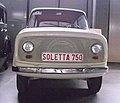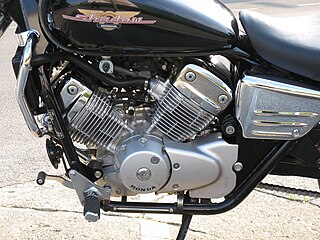
A V-twin engine, also called a V2 engine, is a two-cylinder piston engine where the cylinders are arranged in a V configuration and share a common crankshaft.
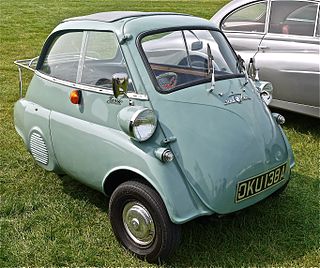
The Isetta is an Italian-designed microcar built under license in a number of different countries, including Argentina, Spain, Belgium, France, Brazil, Germany, and the United Kingdom. Because of its egg shape and bubble-like windows, it became known as a bubble car, a name also given to other similar vehicles.

The Zündapp Janus was a microcar model made by Zündapp in Germany between 1957 and 1958, the only car ever built by the company.

Berkeley Cars Ltd of Biggleswade, Bedfordshire, England produced economical sporting microcars with motorcycle-derived engines from 322 cc to 692 cc and front wheel drive between 1956 and 1960.

The Fiat 1100 is a small family car produced from 1953 until 1969 by the Italian manufacturer Fiat. It was an all-new unibody replacement for the Fiat 1100 E, which descended from the pre-war, body-on-frame Fiat 508 C Balilla 1100. The 1100 was changed steadily and gradually until being replaced by the new Fiat 128 in 1969. There were also a series of light commercial versions of the 1100 built, with later models called the Fiat 1100T, which remained in production until 1971. The Fiat 1100 D also found a long life in India, where Premier Automobiles continued to build the car until the end of 2000.

Motobécane was a French manufacturer of bicycles, mopeds, motorcycles, and other small vehicles, established in 1923. "Motobécane" is a compound of "moto", short for motorcycle; "bécane" is slang for "bike."
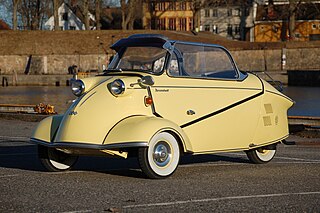
The Messerschmitt Kabinenroller was a series of microcars made by RSM Messerschmitt from 1953 to 1956 and by Fahrzeug- und Maschinenbau GmbH, Regensburg (FMR) from 1956 to 1964. All the Messerschmitt and FMR production cars used the Kabinenroller's monocoque structure, featuring tandem seating and usually a bubble canopy.

The Spatz, later renamed the Victoria 250, is a four-wheeled microcar that was built between 1956 and 1958.

Goggomobil was a series of microcars produced by Hans Glas GmbH in the Bavarian town Dingolfing between 1955 and 1969.

The FMR Tg500 was a sports car built by Fahrzeug- und Maschinenbau GmbH, Regensburg (FMR) from 1958 to 1961. Based on the Messerschmitt Kabinenroller monocoque, which otherwise was a platform for three-wheelers, the Tg500 was a four-wheeled car with a two-stroke straight-two engine. FMR had taken over production of the KR200 from Messerschmitt in 1956. While the KR200 still used the Messerschmitt name and logo, the Tg500 was badged as an FMR.

The BMW 600 is a four-seater microcar produced by the German automaker BMW from mid-1957 until November 1959. Partially based on the BMW Isetta two-seater, it was BMW's first postwar four-seater economy car. It was not a sales success, but it began the design process for its more successful successor, the BMW 700.

S E Opperman was a tractor manufacturer in England. After he saw the Bond Minicar he decided to build his own four-wheel microcar at a factory in Elstree, Hertfordshire.
The Rodley was a British microcar designed by Henry Brown and built by the Rodley Automobile Company in Rodley, West Yorkshire between 1954 and 1956. Henry Brown also designed the Scootacar microcar.
The following outline is provided as an overview of and topical guide to automobiles:
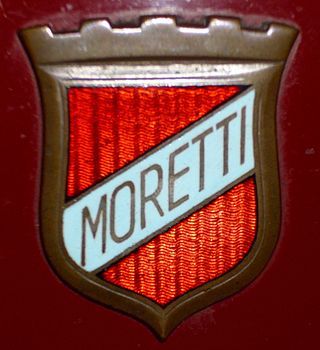
Moretti S.p.A. is a former Italian automobile manufacturer. It was founded in 1925 and ceased automobile production in December 1989. Today, many of its sports car models can still be found at various European auto shows. Moretti Motors produced a variety of models at various times including motorcycles, microcars, and several commercial vehicles.
Egon Brütsch Fahrzeugbau, usually shortened to Brütsch, was a German automotive design and automaker based in Stuttgart, Baden-Württemberg.

Fuldamobil is the name of a series of small cars produced by Elektromaschinenbau Fulda GmbH of Fulda, Germany, and Nordwestdeutscher Fahrzeugbau (NWF) of Wilhelmshaven between 1950 and 1969. Various designated versions of the car were produced, although the vehicles produced under each designation were not always identical and the designations were sometimes misapplied. Though overall numbers produced were relatively small, the cars attracted sufficient attention to see licensed construction on four continents including Europe. In its ultimate configuration it is said to have inspired the term "bubble car". It is acknowledged as the first car in the world to feature a negative scrub radius, now recognised as a major advance in driving safety.

Meadows Frisky is the name of a series of small British cars manufactured at the factory of Henry Meadows Ltd at Fallings Park in Wolverhampton between 1958 and 1961, during which time, production was under the control of a number of companies.

Erling Poppe was an Austrian-born English-raised motor vehicle designer who studied engineering in Birmingham, England, and designed Packman & Poppe Motorcycles, Sunbeam motorcycles and Gordon three-wheeler cars.



